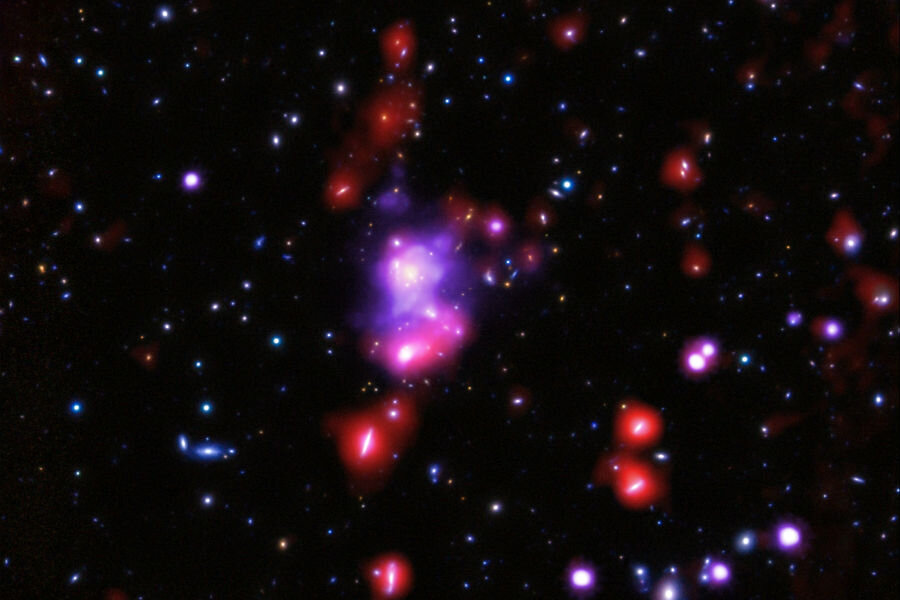How massive galaxy cluster could upend theory of universe evolution
Loading...
The galaxies appear in space like so many Christmas ornaments – red and magenta blobs in X-ray images of what astronomers say is the most massive galaxy cluster yet found for a cluster so young.
At 400 trillion times the sun's mass, a mere 800 million years old, and some 9.6 billion light-years away, the cluster could represent a hint that the most widely accepted explanation for the evolution of universe is flawed, according to the team reporting the measurements in a paper accepted for publication in The Astrophysical Journal.
The theory that has received the most support from observation sets out a timeline in which so-called cold, dark matter initially gathered in small clumps as the universe cooled and settled into a stately expansion following the formative, sudden release of energy known as the big bang and a brief period during which the universe expanded exponentially.
The dark-matter clumps merged over time to provide the gravitational foundations for galaxies, galaxy clusters, and even larger structures. Dark matter earned its name because no one has yet directly detected it. Instead researchers infer its presence by its gravitational effects on matter astronomers can see.
The question the new cluster poses is whether it's too massive given the the pace at which the universe's large-scale structure would have been forming 9.6 billion years ago.
"If you can find a massive-enough cluster in a small-enough volume," or at a sufficient distance, "where things shouldn't have had time enough to grow to that mass," that would represent a challenge to the front-running theory explaining the evolution of the cosmos, says William Forman, an astrophysicist at the Harvard-Smithsonian Center for Astrophysics in Cambridge, Mass.
Dr. Forman, associate director of the center's High Energy Astrophysics Division, was a member of the team measuring the mass of the cluster, formally known as XDCP J0044.0-2033, but informally dubbed Gioiello, Italian for jewel.
Gioiello appeared in a survey of galaxy clusters gathered by the European Space Agency's XMM-Newton X-ray observatory, one of the more recent efforts to identify and take the measure of increasingly distant clusters.
XMM-Newton data only could supply information on the cluster's brightness. The team making these latest measurements used NASA's Chandra X-Ray Observatory. It peered at the cluster for four days to gather enough information to estimated the cluster's size and mass. The cluster measured some 5.5 million light-years across.
“Unlike the galaxy clusters that are close to us, this cluster still has lots of stars forming within its galaxies,” said Joana Santos, a researcher from the National Institute for Astrophysics in Florence, Italy, and other members of the team, in a prepared statement. "This gives us a unique window into what galaxy clusters are like when they are very young.”
The researchers are duly cautious about going beyond "hint" when referring to the find's impact on ideas about the evolution of structure in the universe. This is the second extreme cluster the XMM-Newton survey revealed. Two other surveys have picked up one candidate for extreme clusters each, one of which astronomers dubbed El Gordo. But the uncertainties in the measurements of these objects are larger, Forman cautions.
For instance, a cluster that can look unexpectedly massive and out of place could actually be two clusters that are lined up along an observatory's line of sight.
And so far, too few of these extreme clusters exist to state with any confidence that they do undermine current cosmological theory. Indeed the formal paper reporting the team's results note that as an individual specimen, Gioeillo doesn't appear to pose a significant threat to the theory. But its heft could indicate that even at an earlier stage, it could have been a Baby Huey among young clusters.
So the hunt goes on. In March 2016, for instance, Russia is slated to launch eROSITA, an X-ray observatory for which Germany is building the main element. The observatory will survey the entire sky looking for a range of objects, including some 50,000 to 100,000 galaxy clusters.
But it may take another 15 to 20 years to launch X-ray telescopes with sufficient sensitivity and sky coverage to characterize at least 1,000 clusters – at distances well beyond that of Gioiello – in order to use these structures to test theories of how the universe evolved, the researchers suggest.








